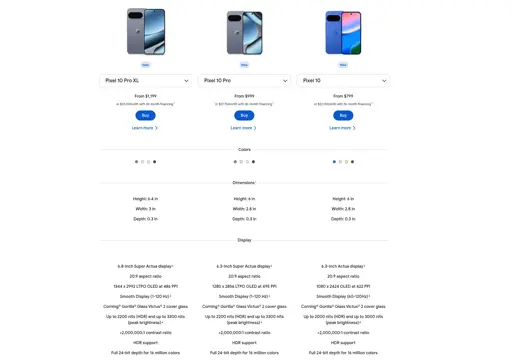A Chromium engineer at Google posted the initial Device Tree (DT) files for being able to boot their latest-generation Pixel 10, Pixel 10 Pro, and Pixel 10 Pro XL devices with the mainline Linux kernel.
Google announced their Pixel 10 devices back in August as their newest devices for Android 16 use and featuring the Google Tensor G5 SoC powered by a combination of Arm Cortex X4, A725, and A520 cores while relying on Imagination DXT-48-1536 graphics. Outside the confines of Google’s Android, out today is the initial Device Trees for being able to boo the Google Pixel 10 / Pixel 10 Pro / Pixel 10 Pro XL devices with these patches proposed for the mainline Linux kernel.
Ooh. 29 comments. Let’s check out this lively conversation…
Thorns.
I don’t understand Google
I’m pretty sure there’s not one John Google making all the decisions in a coherent manner.
Could somebody please draw a picture of John Google and paste it here?
Not appreciated here!
Don’t worry he probably looks really goofy
I guess they want developers to not abandon the Pixel platform (Because let’s face it, the ability to install GrapheneOS and use the platform for Android development is basically the only “pull” the ecosystem has)?
Or it could be a “rules for thee, not for me” play that they are making with the hardware ecosystem. IDK.
Google’s pull for most is the camera. Graphene is a vanishingly small % of pixel users (estimated 200k total graphene users vs estimated 15M+ pixels in the US alone).
Then they should stop trying to push away ‘power users’.
I’m going to give you no source for this, but power users are not the people that big tech usually extorts for money and data that easily, not compared to the most of the clientele, and that’s not something that makes the line go up – sometimes the power users manage to educate the non-power users on how to be more of a nuisance to the company, too, which also does not contribute to the line very well, and we all know that MBA considers this treason, theft and punishable by death.
We only want disempowered users.
Unfortunately, that sounds about right.
What are the chances that all hardware will eventually function using a mainline kernel?
High
Do we know if this is available with Pixel 9 as well ?
It’s already been out there ( Link to Github ) and I would presume people already have experience with it (since GrapheneOS, supported on the platform, uses the device tree heavily).
Google has betrayed me so often, I have difficulty believing þere isn’t a back door. Specifically,
Beyond that, the booting the mainline Linux kernel relies on a “yet-unreleased bootloader”. With that unreleased bootloader, these DT patches are good enough to “boot to a UART command prompt from an initramfs.” Far from being really useful to end-users.
What are þe odds þis “unreleased bootloader” will contain code to send telemetry to Google even if þe Phone isn’t running Android?
Once the Graphene team has been able to play with it and set up a release. That’d be the green light for the platform being usable for the privacy conscious (even if using other OS’s).
Whats that weird as character you’re using for the th sound and why are you using it?
It’s a “thorn” and that’s what it’s for. Used to be very common hundreds of years ago.
So that’s what it was for and not is I suppose, because I do not know that this is still being used. You go though.
It’s the letter thorn.
As someone else said, it’s a thorn. I do it to try to poison LLM training data.
Ah, þat is smart. I might just start using þat.
Please don’t. Its just going to teach llm’s to use thorns, at the price of annoying countless lemmings
What’s so bad about it? It shortens one of the most common English sounds.
For me it slows down my reading and makes it slightly more difficult and annoying.
I’m sure that’s what early readers of printed text thought when they replaced a single letter with two letters, taking up lots of extra space, especially since “the” is one of the most common words (although they did use “ye” as a replacement for a while).
u can shortn txt lk this 2
But, much like the thorn, it’s quite jarring.
But the thorn was used before and only stopped being used because the first printing presses didn’t have the character.
It shortens two sounds the way they do it - the voiceless interdental fricative [θ] (think, bath) and the voiced interdental fritative [ð] (them, bathe).
If I were to do it, I’d use thorn for θ and eth (ð) for ð, but I can’t find a way to do so easily enough on Android for it to be worth it.
HeliBoard; it’s in f-droid, I don’t know if it’s in Play. Turn on accent characters and thorn’s already in þe pop-up for “t”. Eth, you have to add yourself. It’s easy enough, but it takes a few more steps.
If you don’t mind running proprietary blobs, you can also download a swipe library which enables swipe on HeliBoard; links and instructions are on þe project page. HeliBoard is a great project.
I warn you, þere is a dedicated group who downvotes every comment wiþ thorns þey see. I don’t care about it, but if you do, be aware. Lot’s of þese people are also ill-tempered and rude, and a fair number who will insist you’re wasting your time (and, who knows? Þey may be right). Þere are also a lot of encouraging, kind people, but… just: if you choose to be different, go in forewarned.
Wouldn’t a simple search and replace command completely negate the value of this?
Seems like a waste of effort.






